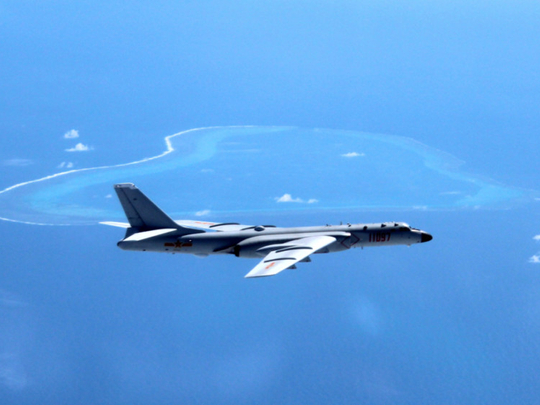
Just as China and the Philippines, and by extension the Association of Southeast Asian Nations (Asean), are settling in for a quiet confidence-building diplomacy, the ostensibly liberal New York Times came out with an editorial — ‘Defiance in the South China Sea’ (SCS) on August 15, 2016. The editorial again pokes China for “worsening tensions”, fuels questions like “freedom of navigation”, which are more of interest to the United States. The editorial makes it all about China and the US whereas, SCS is about China and Southeast Asia.
While the US retches up tempers by calling for respecting the ruling issued under the United Nations Convention on the Law of the Sea (Unclos), of which the US itself is not a signatory, none of the predicted responses, from the contending parties — China and the Philippines — have come true. On the contrary, both have opted for ‘strategic restraint’ and have chosen the path of dialogue to find common ground over SCS.
Boycotting the Unclos tribunal’s proceedings and rejecting its findings, China wants that SCS maritime boundaries be resolved though direct talks between Beijing and the parties concerned. The claims in the SCS overlap amongst China, Taiwan, Vietnam, the Philippines, Malaysia and Brunei.
For now, there is no evidence that China and the Southeast Asian states want to raise tensions. The parties have agreed to the launch of an emergency hotline and to adopt a code for unplanned encounters. The Asean-China summit next month is expected to formally endorse these documents. Both are aimed at managing risks amongst littoral states. Singapore, as the country coordinator of dialogue with China, deserves kudos for facilitating the agreement. Not even mentioning the ruling in the recent joint statement, the parties tend to tacitly accept that the ruling is a hurdle rather than a unifying factor in their relations. Having jettisoned the ruling so early, the Asean will find it hard to lean back on it later.
By appointing former president Fidel Ramos as special envoy for China — one of the most respected figures in the country, the Philippines’ new president, Rodrigo Duterte, has demonstrated maturity in dealing with China. And after a meeting between Ramos and Fu Ying, Chairperson of China’s Foreign Relations Committee, in Hong Kong, both sides are set to begin “a process of formal discussions”.
Those who do not want to see a stable region loathe such positive developments.
Some wonder, why does China claim the areas only through history when much of these are implied in the 1887 Sino-Franco Convention, concerning the Delimitation of the Border Between China and Tonkin; the 1898 Treaty of Paris; the 1900 Treaty of Washington and the 1930 Convention between the US and Britain. Spratly and Paracel Islands returned to China following the 1952 San Francisco Treaty with Japan.
The big question now: Is Asia prepared to live by a set of rules that are made by the victors of the Second World War? The trouble is that international order is changing. As the Chinese economy has grown exponentially since the 1970s, so have its interests, ambitions and power. In addition to securing supply of resources, China wants atonement for the ‘century of humiliation’ suffered at the hands of the West. These assertions are seen as a challenge to the US — the main status-quo power.
The debate is not about ‘freedom of navigation’, which China has guaranteed. It is about how to thwart China’s rise, so it is believed by Beijing and many others. The Chinese are convinced that the US-led maritime coalition of extra-regional players like Japan, India and Australia are a direct threat to China. And so are the ‘Pivot to Asia’ and the Trans-Pacific Partnership. America’s freedom of navigation operations in the areas claimed by China is provocative. In this backdrop, if Washington wants China to change, it must examine its own attitudes and actions towards Beijing.
In nearly 50 years of its existence, Asean has agreed on countless matters, which are of common interest to all its members. In the case of SCS, when China’s differences are with just four of Asean’s ten member-states, this is not an Asean issue, some argue. Should an occasion arise, there is no clause that makes it mandatory for the rest of the members to side with the one that has difference with an outside power. Asean should celebrate its achievements and build on common aspirations rather than falling out on issues that fuel discord. China-bashing as a benchmark of Asean’s unity goes against its own interests.
When others determine time in decades or centuries, the Chinese determine it in millennia. In the Chinese psyche, there is also a belief that the rise of China will resolve contested territorial claims in the SCS and East China Sea in its favour. With time on its side, China is in no hurry. China and Asean share compulsions of geography. As the largest trading nation, poised to become the world’s biggest economy in real terms, there is no good reason why China will impede commercial navigation in the SCS. China’s interests lie in a friendly neighbourhood — interests that run contrary to extra-regional powers. Their involvement will result in perpetual tension and to Asean’s peril.
The message — better make strong friendships in the neighbourhood for mutual benefit.
Sajjad Ashraf is an adjunct professor at the Lee Kuan Yew School of Public Policy, National University of Singapore. He was a member of Pakistan’s Foreign Service from 1973-2008 and had served as Pakistan’s consul general in Dubai during the mid 1990s.










